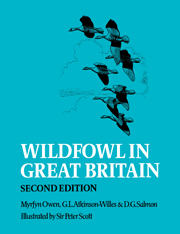Book contents
- Frontmatter
- Contents
- List of location maps
- Foreword by William Wilkinson
- Acknowledgements
- Conventions and abbreviations
- Part I Introduction
- Part II The survey of wildfowl habitat and distribution
- Introduction
- South-west England and southern Wales
- South and south-east England
- East and central England
- North-west England and North Wales
- Teesdale, Tyneside and the Borders
- North Cumbria and south-west Scotland
- South-east Scotland: Forth and Tay
- North-east Scotland
- North-west Scotland
- Part III Species accounts
- Part IV The conservation of wildfowl and their habitats
- Conclusion
- References
- Indexes
North Cumbria and south-west Scotland
Published online by Cambridge University Press: 04 August 2010
- Frontmatter
- Contents
- List of location maps
- Foreword by William Wilkinson
- Acknowledgements
- Conventions and abbreviations
- Part I Introduction
- Part II The survey of wildfowl habitat and distribution
- Introduction
- South-west England and southern Wales
- South and south-east England
- East and central England
- North-west England and North Wales
- Teesdale, Tyneside and the Borders
- North Cumbria and south-west Scotland
- South-east Scotland: Forth and Tay
- North-east Scotland
- North-west Scotland
- Part III Species accounts
- Part IV The conservation of wildfowl and their habitats
- Conclusion
- References
- Indexes
Summary
The Solway Basin
The Solway Basin, lying partly in England and partly in Scotland, is deservedly famous for its large and widespread population of geese, for its great expanses of foreshore and merse, for its popularity as a wildfowling centre, and for the various conservation measures, both formal and informal, which may have helped to correct the earlier trend towards excessive shooting. Over the past half century the changing pattern of disturbance has had a marked effect on the local distribution of the geese, but taken as a whole the peak numbers within the region are now larger than ever before. Whooper Swans are also plentiful, but in common with the ducks the concentrations at any one place are seldom outstandingly large.
Although the firth is the primary centre of interest, the numerous inland waters and marshes are frequently used in preference to the coast, and together support a sizeable population of breeding and wintering wildfowl. Many of the more important sites are now protected to a greater or lesser degree, either by the owners or by one of the voluntary bodies, such as the RSPB, the Scottish Wildlife Trust and the Cumbria Trust for Nature Conservation. Statutory reserves are also established on Siddick Pond, near Workington, on the Castle and Hightae Lochs, Lochmaben, and on the merse and foreshore at Caerlaverock, by Dumfries.
Inland waters of north Cumbria
The inland waters on the English side of the firth have much in common with those in south Lakeland, and carry a similar population of breeding and wintering ducks. Greylags and Whooper Swans also winter in some numbers, and there is in addition a feral population of several hundred Greylags and Canada Geese.
- Type
- Chapter
- Information
- Wildfowl in Great Britain , pp. 211 - 234Publisher: Cambridge University PressPrint publication year: 1986



